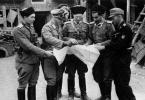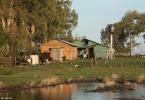Calculus trainer- easily and significantly increases the intellectual potential of a person.
The result of acquiring skills and completing the standard qualification will be the assignment of a sports category (I category, II category, III category, candidate master of sports, master of sports and grandmaster).
- People from the group are distinguished both by the ability to speak beautifully and correctly, and by the ability to quickly count in the mind, and, as a rule, they are classified as smart. The ability to quickly count in the mind allows a student to study more successfully, and an engineer and a scientist to reduce the time for obtaining the result of their activities.
- CS is needed not only for schoolchildren, but also for engineers, teachers, medical workers, scientists and managers of various levels. Who quickly considers, it is easier for him to study and work. US is not a toy, although it entertains. It allows the student to return to those "rails" from which he once fell; increases the speed and quality of perception of information; disciplines and produces accuracy in everything; teaches to notice details and trifles; teaches to save; creates images of objects and phenomena; allows you to foresee the future and develops human intelligence.
- "Renovation" in the head should begin with simple arithmetic operations that allow you to structure the brain.
- The ability to quickly count in the mind gives the student self-confidence. As a rule, those who do well at school or at a university are the fastest to count in their minds. If a lagging student is taught to quickly count in his mind, then this will certainly have a beneficial effect on his academic performance, and not only in natural, but also in all other subjects. This has been proven by practice.
- Arbitrary attention and interest during oral counting changes the wandering gaze of a lagging student to a fixed one, and the concentration of attention reaches several floors of the depth of the subject or process that is being studied.
- “The study of mathematics disciplines thinking, accustoms to the correct verbal expression of thoughts, to the accuracy, conciseness and clarity of speech, cultivates perseverance, the ability to achieve the intended goal, develops working capacity, and contributes to the correct self-assessment of mastering the subject that is being studied.” (Kudryavtsev L.D. - corresponding member of the Russian Academy of Sciences. 2006.).
- A student who has learned to quickly count in his mind, as a rule, begins to think faster.
- He who by his nature counts well will naturally find intelligence in any other science, and he who calculates slowly, learning this art and mastering it, will be able to improve his mind, make it sharper (Plato).
- The acquired skills of oral counting will be enough for some for 5-10 years, and for others for life.
- It will be easier for our descendants to learn and gain knowledge. However, the culture of oral counting will always be an integral part of human culture.
- Those who quickly calculate in their minds tend to think clearly, perceive quickly, and see deeper.
- Mastering the CS develops figurative, diagrammatic and systemic thinking, expands the working memory, the range of perception, accustoms to thinking several moves ahead, improves the quality of thinking, operating with the quantitative characteristics of objects.
- SS increases clarity of thinking, self-confidence, as well as strong-willed qualities (patience, perseverance, endurance, diligence). Accustoms to a deep and stable concentration of attention, conjecture and finishing the started phrases (especially for preschoolers and primary school students).
Free program and arithmetic game allows children learn addition, subtraction, multiplication and division of numbers, including single digits, double digits, natural positive numbers within the subject of mathematics with the help of colorful pictures of fruits and berries, insects and amazing animals, as well as images of other nature characters.
The educational game program is designed for preschoolers and children in grades 1, 2, 3 of elementary school and allows you to choose one of the arithmetic operations on numbers in the form of a math game: addition, multiplication, subtraction or division.
With the help of bright and colorful images, children are interested in learning how to perform elementary operations with numbers.
A child can both study actions on single-digit and double-digit numbers, and by training, consolidate the material. In the game, the student can independently choose not only the arithmetic operation to study, but also one of three levels of difficulty.
In the program, the child is shown in turn simple examples and their display in the form of an appropriate number of pictures. It is not necessary to enter the numerical result of the example, the student selects the number of pictures corresponding to the answer with the mouse.
For example, when learning addition at the initial stage, the child counts the number of apples in the first and second terms together and selects the corresponding number of apples with the mouse in the answer. The program shows the correctness or incorrectness of the answer and counts their number.
Simulator-game Arithmetic
This game or simulator contains 12 examples in each difficulty level. If necessary, you can increase the number of examples up to 23 by adding invented examples to the appropriate text files. At the same time, new pictures are automatically offered, although this may include the mode of addition or subtraction, multiplication or division of numbers.
- Unpack and run the game (Sapling 2.0.exe file);
- In the top menu, select the arithmetic operation (Addition, Subtraction, Multiplication, Division) and the difficulty level (1, 2, 3);
- Press "Start" in the menu.
- After selecting with the mouse, in your opinion the correct number of pictures, click the "Ok" button.
Operating system: Windows 98/ME/2000/XP/2003/Vista/7/8
Interface language: Russian.
Game Author: Kononov Vitaliy, student of the 11-A grade of the comprehensive school No. 43 in Simferopol, project work.
Scientific adviser: Informatics teacher Andreychuk Nikolai Vasilyevich.
Size: 357.91 Kb
Year of release of the program: 09.04.2002
The program is designed for free download.
When placing a training program or its description on other sites, a direct link to this author's page is a prerequisite!
Arithmetic is the most basic, basic section of mathematics. It owes its appearance to the needs of people in the account.
mental arithmetic
What is mental arithmetic? Mental arithmetic is a method of learning to count quickly, which came from antiquity.
At present, unlike the previous one, teachers are trying not only to teach children the speed of counting, but also try to develop thinking.
The learning process itself is based on the use and development of both hemispheres of the brain. The main thing is to be able to use them together, because they complement each other.
Indeed, the left hemisphere is responsible for logic, speech and rationality, while the right hemisphere is responsible for imagination.
The training program includes training in operation and the use of a tool such as abacus.
Abacus is the main tool in the study of mental arithmetic, because students learn to work with them, sort out the bones and realize the essence of counting. Over time, the abacus becomes your imagination, and the students imagine them, build on this knowledge and solve examples.
Feedback on these teaching methods is very positive. There is one minus - training is paid, and not everyone can afford it. Therefore, the path of a genius depends on the financial situation.
Mathematics and arithmetic
Mathematics and arithmetic are closely related concepts, or rather, arithmetic is a section of mathematics that works with numbers and calculations (actions with numbers).
Arithmetic is the main section, and therefore the basis of mathematics. The basis of mathematics is the most important concepts and operations that form the basis on which all subsequent knowledge is built. The main operations include: addition, subtraction, multiplication, division.
Arithmetic, as a rule, is studied at school from the very beginning of training, that is. from first grade. Children learn the basics of mathematics.
Addition- this is an arithmetic operation, during which two numbers are added, and their result will be a new - third.
a+b=c.
Subtraction- this is an arithmetic operation, during which the second number is subtracted from the first number, and the third number will be the result.
The addition formula is expressed as follows: a - b = c.
Multiplication is an action, as a result of which the sum of identical terms is found.
The formula for this action is: a1+a2+…+an=n*a.
Division is the division into equal parts of a number or variable.

Sign up for the course "Speed up mental counting, NOT mental arithmetic" to learn how to quickly and correctly add, subtract, multiply, divide, square numbers and even take roots. In 30 days, you will learn how to use easy tricks to simplify arithmetic operations. Each lesson contains new techniques, clear examples and useful tasks.
Learning arithmetic
Arithmetic is taught within the walls of the school. From the first grade, children begin to study the basic and main section of mathematics - arithmetic.
Number addition
Arithmetic rules
The order in which operations are performed in an expression is very important!
If the example has the form 2+3-4, then the order in it can be anything. Because addition and subtraction operations have the same precedence. If we perform addition first, we get: 5-4=1, and if we subtract first, then: 2-1=1. As you can see the result is the same.
Similarly with the expression of multiplication and division. The multiplication and division operations have the same precedence. For example, 2 8:4. Let's do the multiplication first: 16:4=4, and if the division: 2 2=4.
Order makes sense when an expression mixes addition or subtraction with multiplication or division. For example:
2+22. The first action is performed ALL operations of multiplication and division, and only then addition and subtraction. That is the expression 2+2 2 = 2+4=6.
But there are brackets in the expressions. Parentheses tend to change the order of operations. Consider the previous example, only with brackets: (2+2)*2. In this case, the operations inside the brackets are performed first, and then outside the brackets, in order: 1. Multiplication and division 2. Addition and subtraction.
So, (2+2) 2=4 2=8.
As you can see from the examples, parentheses have a role. And the order of operations is the same.

Arithmetic lessons
Arithmetic lessons - school lessons, up to the sixth grade. Further, mathematics opens its sections: geometry and algebra, and later trigonometry.
Arithmetic Grade 5
In the fifth grade, the student begins to study such topics as: fractional numbers, mixed numbers. You can find information about operations with these numbers in our articles on the corresponding operations.
A fractional number is the ratio of two numbers to each other or the numerator to the denominator. A fractional number can be replaced by the division operation. For example, ¼ = 1:4.
mixed number is a fractional number, only with a highlighted integer part. The integer part is allocated provided that the numerator is greater than the denominator. For example, there was a fraction: 5/4, it can be converted by highlighting the whole part: 1 whole and ¼.
Examples for training:
Task number 1:

Task number 2:

Arithmetic Grade 6
In the 6th grade, the topic of converting fractions to lowercase appears. What does it mean? For example, given a fraction ½, it will be equal to 0.5. ¼ = 0.25.
Examples can be written in this style: 0.25+0.73+12/31.
Examples for training:
Task number 1:

Task number 2:

Games for the development of mental counting and counting speed
There are wonderful games that help develop counting, help develop math skills and mathematical thinking, mental counting and counting speed! You can play and develop! You are interested? Read short articles about games and be sure to try yourself.
Game "Quick Score"
The "quick counting" game will help you speed up your mental counting. The essence of the game is that in the picture presented to you, you will need to choose a yes or no answer to the question "are there 5 identical fruits?". Follow your goal, and this game will help you with this.

Game "Mathematical Comparisons"
The Math Comparison game will require you to compare two numbers against the clock. That is, you have to choose one of two numbers as quickly as possible. Remember that time is limited, and the more you answer correctly, the better your math skills will develop! Shall we try?

Game "Fast Addition"
The game "Fast Addition" is an excellent quick counting simulator. The essence of the game: given a field 4x4, that is. 16 numbers, and above the field is the seventeenth number. Your goal is to use sixteen numbers to make 17 using the addition operation. For example, you have the number 28 written above the field, then in the field you need to find 2 such numbers that add up to the number 28. Are you ready to try your hand? Then go ahead, train!

Development of phenomenal mental arithmetic
We have considered only the tip of the iceberg, in order to understand mathematics better - sign up for our course: Speed up mental counting - NOT mental arithmetic.
From the course, you will not only learn dozens of tricks for simplified and fast multiplication, addition, multiplication, division, calculating percentages, but also work them out in special tasks and educational games! Mental counting also requires a lot of attention and concentration, which are actively trained in solving interesting problems.
Speed reading in 30 days
Increase your reading speed by 2-3 times in 30 days. From 150-200 to 300-600 wpm or from 400 to 800-1200 wpm. The course uses traditional exercises for the development of speed reading, techniques that speed up the work of the brain, a method for progressively increasing the speed of reading, understands the psychology of speed reading and the questions of course participants. Suitable for children and adults reading up to 5,000 words per minute.
Development of memory and attention in a child 5-10 years old
The purpose of the course is to develop the child's memory and attention so that it is easier for him to study at school, so that he can remember better.
After completing the course, the child will be able to:
- 2-5 times better to remember texts, faces, numbers, words
- Learn to remember for longer
- The speed of remembering the necessary information will increase
154947
Mental arithmetic at home. Teaching mental math for adults online free download. Simple addition and subtraction. Download examples for free. Examples of actions on the abacus. Auxiliary beads (brothers and friends).
The material is prepared for parents and children for educational purposes! For educational materials and classes, contact the developing clubs in your city.
Acquaintance with Abacus
- outer frame
- top row of beads (brothers): value 5
- bottom row of beads (friends): value 1
- calculated (separating) ruler
Examples of actions on the abacus
When working with the abacus, use your thumb and forefinger.
Add the lower beads (friends) with your thumb and subtract with your index finger.
Top beads (brothers) add and subtract only with your index finger. 
For example, let's take only ones and tens and compare the numbers and values on the accounts. 
Exercise 1: write down the values shown on the accounts.
Simple addition and subtraction
Perform all calculations from left to right (this will make it easier to calculate when working with large numbers). 
Task 2: simple addition and subtraction
Auxiliary beads (brothers and friends)
- If there is a shortage of beads, use the top bead (help from a brother) or a bead from the next rod (help from a friend).
- We use the top bead (brother's help) for two groups of numbers, which add up to 5: 1 and 4; 2 and 3.
- We use a bead from the next rod (friend's help) for five groups of numbers, which add up to 10: 1 and 9; 2 and 8; 3 and 7; 4 and 6; 5 and 5.
Addition 5: help from a brother

Task 3: Addition 5: help from a brother
Subtraction 5: Brother Help

Task 4: Subtraction 5: Brother Help
Addition 10: help from a friend

Subtract 10: help a friend

Task 5: Addition and Subtraction 10: Help from Friends
Did you like the activity? Put hearts and subscribe to us on social networks:



